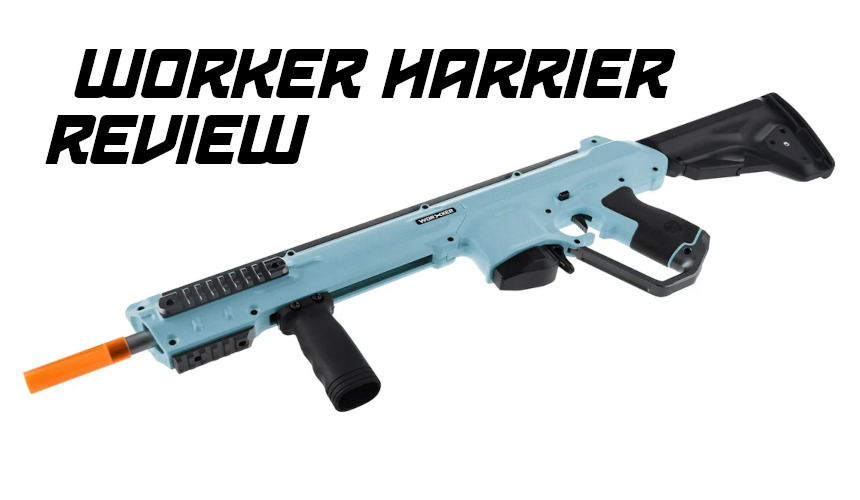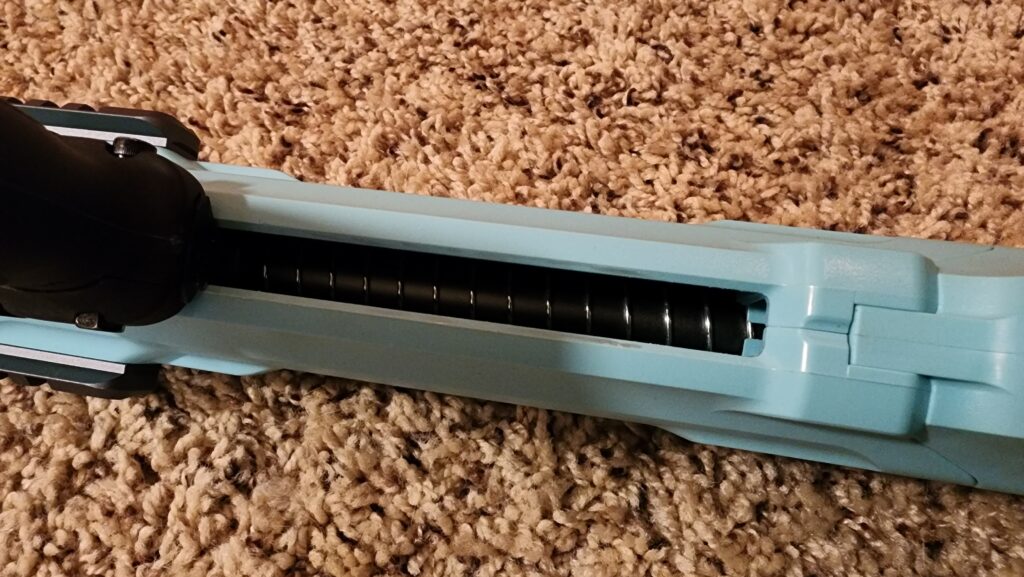

Worker Harrier
Worker
$180-$190
150 to 300+ fps (variable based on spring and barrel)
Two darts per second
An extremely capable, if pricey, competitive dart flinging setup.
Worker Harrier Review
February 26, 2023Author’s note: since CC was out of stock as of this posting, you might try placing an order with Out of Darts!
This review is an odd one for me. Usually, I leave the “outside” brands alone, in favor of things you can find on store shelves and/or Amazon. After seeing that Containment Crew had some in stock, though, I jumped at the chance to have a Harrier. Given just how many “pro” blasters of this form factor exist, it seemed fitting to actually grab a Harrier for comparison.
As of this writing? The Harrier is absolutely a worthy competitor in this space, but more so if you’re willing to pay a premium price to not have to do the work for higher dart velocity.
Injection Molded Goodness
 Right off the bat, you notice the quality of the blaster when you open the box. The Harrier is made of solid, injection-molded plastic, with metal parts for the rails and hand guard. Just as importantly, while the blaster is made to be (somewhat) taken apart, those features are made with durability in mind – the various screws go into heat-set inserts instead of plastic. Several of the best community-made, 3d-printed blasters are designed with inserts in mind for easy/consistent disassembly. Having a manufacturer do the same is a great thing to see.
Right off the bat, you notice the quality of the blaster when you open the box. The Harrier is made of solid, injection-molded plastic, with metal parts for the rails and hand guard. Just as importantly, while the blaster is made to be (somewhat) taken apart, those features are made with durability in mind – the various screws go into heat-set inserts instead of plastic. Several of the best community-made, 3d-printed blasters are designed with inserts in mind for easy/consistent disassembly. Having a manufacturer do the same is a great thing to see.
In addition, the grip is large but comfortable and sturdy. I have nothing to complain about there.
 The Harrier comes in two parts, not unlike the Dart Zone Pro Mk1.2. The front mates with the back, and you have to put the two together. In this case, however, the front half includes the priming bars, breech, and the forward part of the plunger tube. In addition, the top (metal) Picatinny rail extends along the entire length, further strengthening the shell. It does mean you have plenty of screws to remove if you want to take the blaster apart and replace the main spring. So it’s not a quick spring swap. At the same time, though, the blaster is rock solid and ready for use and abuse.
The Harrier comes in two parts, not unlike the Dart Zone Pro Mk1.2. The front mates with the back, and you have to put the two together. In this case, however, the front half includes the priming bars, breech, and the forward part of the plunger tube. In addition, the top (metal) Picatinny rail extends along the entire length, further strengthening the shell. It does mean you have plenty of screws to remove if you want to take the blaster apart and replace the main spring. So it’s not a quick spring swap. At the same time, though, the blaster is rock solid and ready for use and abuse.
In addition to being able to change the main spring, you can change the barrel simply by unscrewing it. The Harrier comes with two springs and two barrels; though you can order stronger springs and longer barrels, the ones included are good enough for most players.
You also have two rails on either side of the blaster, and one underneath at the front. Rails everywhere!
Finally, a SCAR barrel is included for improving dart accuracy, especially at higher velocities.
Blaster Operation
 The Harrier is easy to use; pull back on the priming grip to compress the spring, push the grip forward, then depress the trigger to fire. That’s how simple it is!
The Harrier is easy to use; pull back on the priming grip to compress the spring, push the grip forward, then depress the trigger to fire. That’s how simple it is!
Actually, it’s even simpler. The Harrier has a spring-return mechanism for the priming handle!
Thanks to a skinny pusher, the magazine can be inserted at any time. Older blasters required you to prime the blaster and open the breech, so this is an improvement, at least in terms of *when* you can change magazines. In addition, there is no priming lock. If you choose, you can de-prime the blaster; this latter feature is largely dependent on the user as to whether it’s good or not.
The blaster comes with a small, form-fitting magazine to fit the profile, but is able to use the various “straight” Talon magazines as well, with a very slight magwell flare to assist in reloading. On the back end, the adjustable stock works, but can be replaced with any M4 buffer stock. The Allen key used for separating the blaster halves is stored in the buffer tube, underneath the stock.
The forward priming grip ships unattached; the Picatinny rail used for attaching it can be used for the grip of your choice. I like the stock grip, personally, but the option to change is excellent. A “bolt-action” attachment is included, but I’m personally not a fan.
Finally, priming the blaster is smooth. REALLY smooth. It’s far more comfortable than other blasters. That, plus the solid (if heavy) blaster construction, makes for a great experience.
Performance and Gameplay
Admittedly, I haven’t used the Harrier in all potential setups – I still need to buy extra barrels and springs for experimentation. Even so, running the blaster near 200fps has been largely issue free. The blaster does prefer fresh or somewhat fresh darts; I’ve had well-used club darts fire inconsistently. If you’re using the blaster competitively, though, you should be using fresh darts anyway.
With the long priming motion and no slam-fire, two darts per second is the maximum rate of fire you should expect. Given that you can push this blaster to 300fps, though, trading off rate of fire is quite acceptable.
If your normal gameplay is below 150fps, though, the Harrier is probably not for you. It’s actually hard to get it to shoot that slow, and if you do, it becomes very inconsistent. This is very much meant for high-speed, competitive play.
Internals
I haven’t bothered to open my blaster up, especially since the “important bits” can all be accessed when swapping springs. In case you’re interested, though…
View this post on Instagram
Final Thoughts
The Harrier is pricy, there’s no denying that. But it’s such a solid blaster out of the box, with so much customization potential (and relatively inexpensive ways to raise performance), that the price point becomes very easy to justify. If you’re operating solely on the low end of its performance (150-200fps), I can understand going for cheaper options like the Gameface Trion or the Dart Zone Pro series. But if your fps needs extend beyond that (or you simply want a blaster that feels great to operate), the Harrier is definitely worth a look.

